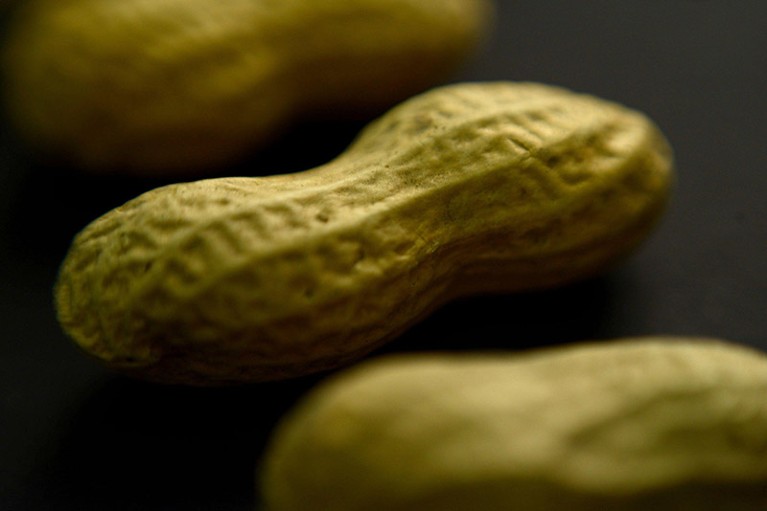
Omalizumab was given to children who were severely allergic to peanuts and at least two other foods.Credit: Patrick Sison/AP via Alamy
For people with food allergies, accidentally eating the wrong thing could prove deadly. Now, for the first time, an asthma drug has been shown to protect people from severe reactions if they ingest a small amount of a food they’re allergic to.
In a study reported on 25 February in the New England Journal of Medicine1, researchers tested a drug called omalizumab in 3 adults and 177 children aged between one and 17 who were severely allergic to peanuts and at least two other foods. After about four months of treatment, 67% of those who received the drug were able to ingest the equivalent of two or three peanuts without it causing a significant reaction, compared with just 7% of those who received a placebo. Omalizumab seemed to be similarly effective at raising participants’ tolerance to other foods they were allergic to, including cashews, milk and eggs.
Research round-up: Allergies
“This is a huge breakthrough for food-allergy treatment,” says Ruchi Gupta, a paediatrician at Northwestern University Feinberg School of Medicine in Chicago, Illinois. She points out that although the drug doesn’t offer an outright cure for food allergies, it lowers the risk that ingesting a trace amount of the food will prove catastrophic. “Having treatments that can make people feel safer [while eating] is just wonderful.”
On the basis of this evidence, the US Food and Drug Administration (FDA) approved omalizumab as a treatment for food allergies earlier this month.
Nature looks at the promise and limitations of the new treatment, and other ways food allergies could be treated in the future.
How does omalizumab work?
Omalizumab, known commercially as Xolair, isn’t a new drug: the FDA approved it for the treatment of asthma in 2003 and, later, for chronic hives and for nasal polyps that occur with certain breathing conditions.
The drug is a monoclonal antibody designed to attack a specific type of human antibody known as IgE. Like other antibodies, IgE is produced by immune cells when the body perceives a specific protein to be a threat. But if that protein is an allergen, such as peanut protein or cat dander, IgE causes unnecessary inflammation that can prompt the body to go into anaphylactic shock. Omalizumab recognizes all kinds of IgE antibody — including those that attack air pollutants in asthma and those that attack food proteins. Researchers have long suspected that the drug could also be useful for treating food allergies, Gupta says.
The drug must be injected once every two to four weeks, depending on the allergic person’s weight and the severity of their reaction, and can cost more than US$1,400 per injection.
What makes it different from other treatments?
The FDA has approved only one other treatment for a food allergy — a peanut-protein powder called Palforzia. Approved in 2020 for children aged four years and over, Palforzia works by allowing the immune system to build up a tolerance to peanuts over time. This is done by gradually increasing the dosage over the course of about six months. Conversely, omalizumab starts to work immediately and has been shown to be safe in children as young as one year old.
Moreover, because the monoclonal antibody attacks all kinds of IgE antibody, it can be used for allergies to foods other than peanuts. “It theoretically should work as well for any different food allergy that that person has,” says the study’s lead author Robert Wood, a paediatric allergy specialist at Johns Hopkins University School of Medicine in Baltimore, Maryland. He says omalizumab might also work for other autoimmune conditions that people taking it have, such as pollen allergies and eczema.
What are the drug’s limitations?
The study didn’t find any adverse side effects associated with taking omalizumab. But Wood cautions that lowering a person’s natural IgE antibody defences could make them more vulnerable to infection with parasitic worms.
Perhaps the drug’s most important limitation is that it doesn’t eliminate allergies — it only raises the threshold for the amount of food a person can eat before it triggers a reaction. In the FDA’s statement approving omalizumab, the agency said that people taking the drug “must continue to avoid foods they are allergic to”.
“The biggest worry is that patients may be assuming that their protection from food reactions is pretty complete,” Wood says. He says researchers will be monitoring whether people who take the drug start taking more risks and having more reactions as a result.
What don’t we know about it?
Although omalizumab increases the amount of food needed to trigger an allergic reaction, Gupta says it’s not clear whether it can decrease the severity of a reaction if a person goes far over that limit — consuming a handful of peanuts, for example.
And Wood says he and others are now studying why the results varied so widely between individuals: at the end of the trial, 14% of the participants who took omalizumab were still unable to consume even a fraction of one peanut without having a reaction. Working out why some people don’t respond well, he says, will help clinicians to determine who will benefit most from the drug.
What other food-allergy treatments are on the horizon?
Researchers are currently testing another monoclonal antibody approved for the treatment of asthma and eczema, dupilumab, in people with peanut allergies. Dupilumab targets signalling molecules, released by immune cells, that trigger inflammation. And researchers are testing a eczema drug called abrocitinib, which blocks certain types of signalling pathway in immune cells, as a treatment for multiple food allergies.
Other trials are testing simpler treatments. Gupta, for instance, is studying whether feeding four-month-old infants small amounts of eight common allergens such as wheat and shellfish can head off the development of allergies. “Having new choices for treatments is really just going to help this field so much,” she says.


